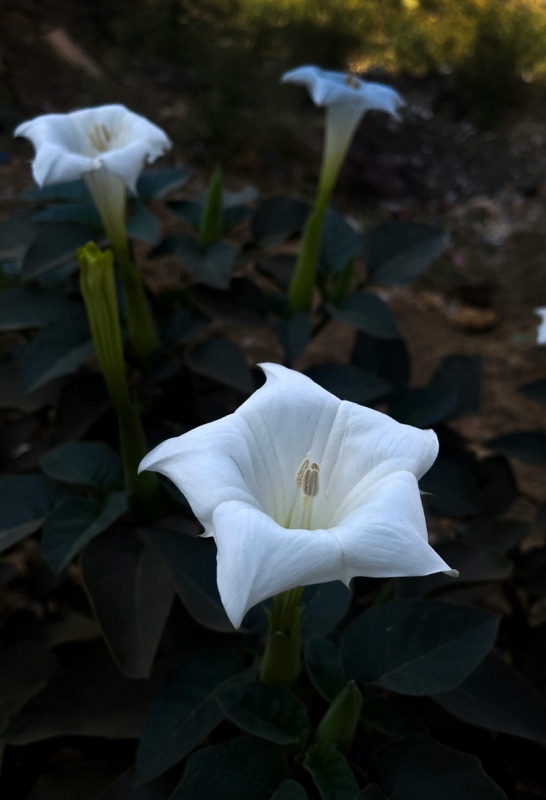Datura (Devil’s Trumpet)
by Wanderer MoonChild
Botanical Basics
- Common Name(s): Datura, Devil’s Trumpet, Jimsonweed, Thorn Apple, Moonflower, Sacred Datura
- Folk Name(s): Devil’s Weed, Hell’s Bells, Witches’ Weed, Mad Apple
- Scientific/Latin Name: Datura stramonium (also includes related species like D. innoxia, D. metel)
- Family: Solanaceae (Nightshade family)
- Plant Type: Annual or short-lived perennial herb
- Botanical Description: Upright branching plant, 2–5 feet tall, with large ovate leaves, spiny seed pods, and striking trumpet-shaped flowers (white, purple, or yellow). Blooms open at dusk or night, releasing a strong, often intoxicating fragrance.
- Growing Zones/Climate: Hardy in USDA Zones 5–10, often grown as an annual in cooler climates.
- Best Zones for Growth: Warm, sunny, well-drained regions—commonly thrives in disturbed soils and wild edges.
- Habitat & Range: Native to the Americas; now naturalized worldwide. Found in fields, roadsides, and waste ground.
Cultivation & Harvest
- Soil & Sun Requirements: Prefers rich, well-drained soil in full sun. Can tolerate poor soils but not excessive shade.
- Propagation: Typically from seed. Seeds require scarification or stratification to germinate. Self-seeds readily.
- Companion Planting: Rarely recommended due to toxicity. Historically planted at the edges of gardens as a protective or warding plant.
- Harvesting Guidelines: Extreme caution—wear gloves. All parts are poisonous. Traditionally harvested ritually rather than medicinally by laypersons.
- Drying/Preservation: Not recommended for consumption. Historically dried for shamanic/ritual smoke blends but extremely dangerous.
Traditional & Historical Use
- Cultural Significance: Used by Indigenous peoples of the Americas in sacred rites, vision quests, and divination. Also found in Indian Ayurveda and in some European magical traditions. Considered both sacred and dangerous—a plant of initiation.
- Traditional Medicine: Historically used in very small, controlled doses as an anesthetic, antispasmodic, or asthma remedy. Smoked or inhaled for respiratory issues. Modern herbalism does not recommend internal use due to toxicity.
- Symbolism: Represents crossing thresholds, altered states, death-rebirth cycles, and initiation into mysteries.
Medicinal & Practical Properties
- Active Constituents: Tropane alkaloids including atropine, scopolamine, hyoscyamine.
- Medicinal Uses (historical, not recommended today):
- Asthma powders (smoked leaves)
- Sedative or pain relief in folk medicine
- Treatment for motion sickness, cramps, and nervous disorders in highly controlled doses
- Preparation Methods: Historically tinctures, ointments, and smoking blends. Today limited to pharmaceutical alkaloid extraction under strict control.
- Dosage & Guidelines: Unsafe to self-administer. Traditional dosages were minute and ritualized; overdose can easily be fatal.
- Safety/Precautions: All parts are highly toxic. Symptoms of poisoning include hallucinations, delirium, rapid heartbeat, seizures, coma, and death. Should only be handled externally with care; not recommended for internal use outside of professional pharmaceutical processing.
Magical & Spiritual Properties
- Elemental Association: Fire & Spirit
- Planetary/Deity Correspondence: Saturn (baneful herbs, initiation); sometimes linked with Hecate, Shiva, and underworld/liminal deities.
- Magical Correspondences: Transformation, shadow work, astral travel, protection, banishing, dream work.
- Ritual Use: Used by shamans and witches historically for trance, astral journeying, and crossing between worlds. Seeds and flowers may be placed on altars as offerings rather than consumed.
- Symbolism in Divination/Dreams: Appearing in dreams may signal hidden dangers, veiled truths, or initiation into deep mysteries.
Ecological & Culinary Uses
- Pollinator Value: Night-blooming flowers attract moths and nocturnal pollinators (especially hawk moths).
- Wildlife Uses: Generally avoided by herbivores due to toxicity. Seeds may be eaten by some birds, though many species are poisoned.
- Culinary Uses: None. Highly poisonous—never edible.
Household/Practical Uses
- Quick Uses: Protective warding plant in gardens; placed near boundaries to repel unwanted spirits or energies.
- Notable Traits: Night-blooming, fragrant, but toxic; spiny seed pods add a natural protective quality.
- Special Notes: Known as both a “witch’s ally” and a “baneful herb”—a plant of power and danger. Always treat with respect and caution.
Fast Facts
- Highly toxic, with historical shamanic and magical use
- Striking night-blooming flowers, associated with mystery and initiation
- Should never be ingested—ritual or symbolic use only in modern practice

📖 Supporting Notes
- Grieve, Maud. A Modern Herbal. 1931.
- Chevallier, Andrew. Encyclopedia of Herbal Medicine. DK Publishing, 2016.
- Rätsch, Christian. The Encyclopedia of Psychoactive Plants. Park Street Press, 2005.
- Cunningham, Scott. Cunningham’s Encyclopedia of Magical Herbs. Llewellyn, 1985.
No comments:
Post a Comment